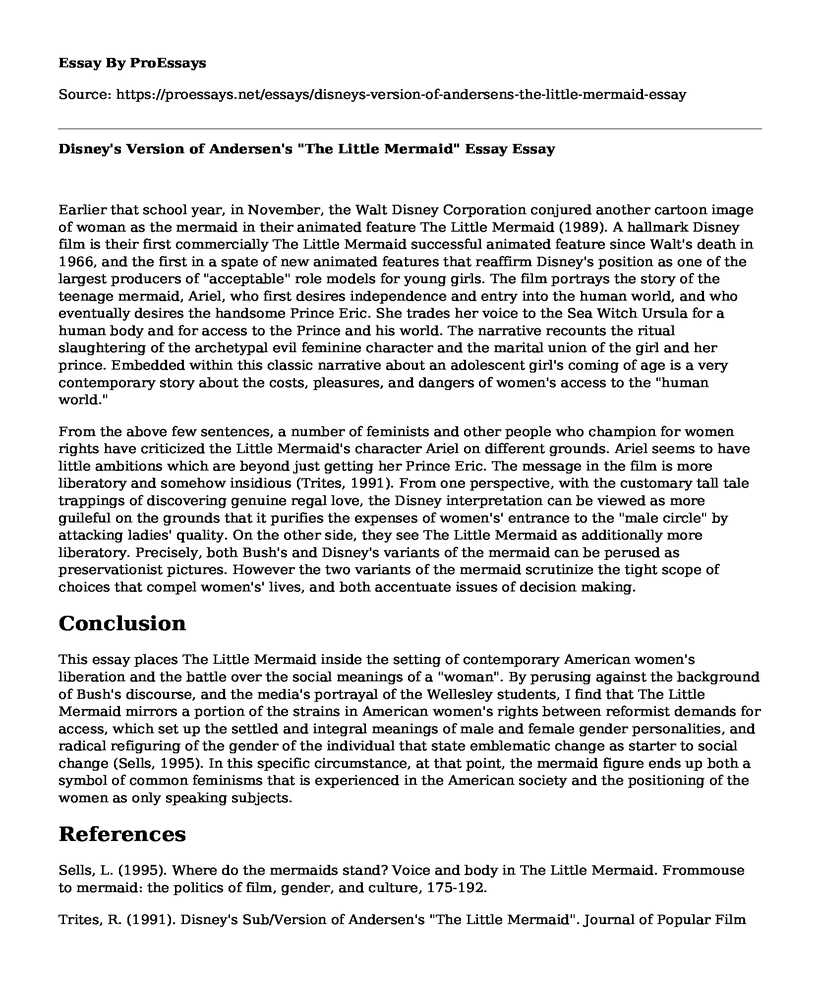Earlier that school year, in November, the Walt Disney Corporation conjured another cartoon image of woman as the mermaid in their animated feature The Little Mermaid (1989). A hallmark Disney film is their first commercially The Little Mermaid successful animated feature since Walt's death in 1966, and the first in a spate of new animated features that reaffirm Disney's position as one of the largest producers of "acceptable" role models for young girls. The film portrays the story of the teenage mermaid, Ariel, who first desires independence and entry into the human world, and who eventually desires the handsome Prince Eric. She trades her voice to the Sea Witch Ursula for a human body and for access to the Prince and his world. The narrative recounts the ritual slaughtering of the archetypal evil feminine character and the marital union of the girl and her prince. Embedded within this classic narrative about an adolescent girl's coming of age is a very contemporary story about the costs, pleasures, and dangers of women's access to the "human world."
From the above few sentences, a number of feminists and other people who champion for women rights have criticized the Little Mermaid's character Ariel on different grounds. Ariel seems to have little ambitions which are beyond just getting her Prince Eric. The message in the film is more liberatory and somehow insidious (Trites, 1991). From one perspective, with the customary tall tale trappings of discovering genuine regal love, the Disney interpretation can be viewed as more guileful on the grounds that it purifies the expenses of women's' entrance to the "male circle" by attacking ladies' quality. On the other side, they see The Little Mermaid as additionally more liberatory. Precisely, both Bush's and Disney's variants of the mermaid can be perused as preservationist pictures. However the two variants of the mermaid scrutinize the tight scope of choices that compel women's' lives, and both accentuate issues of decision making.
Conclusion
This essay places The Little Mermaid inside the setting of contemporary American women's liberation and the battle over the social meanings of a "woman". By perusing against the background of Bush's discourse, and the media's portrayal of the Wellesley students, I find that The Little Mermaid mirrors a portion of the strains in American women's rights between reformist demands for access, which set up the settled and integral meanings of male and female gender personalities, and radical refiguring of the gender of the individual that state emblematic change as starter to social change (Sells, 1995). In this specific circumstance, at that point, the mermaid figure ends up both a symbol of common feminisms that is experienced in the American society and the positioning of the women as only speaking subjects.
References
Sells, L. (1995). Where do the mermaids stand? Voice and body in The Little Mermaid. Frommouse to mermaid: the politics of film, gender, and culture, 175-192.
Trites, R. (1991). Disney's Sub/Version of Andersen's "The Little Mermaid". Journal of Popular Film and Television, 18(4), 145-152.
Cite this page
Disney's Version of Andersen's "The Little Mermaid" Essay. (2022, Jun 18). Retrieved from https://proessays.net/essays/disneys-version-of-andersens-the-little-mermaid-essay
If you are the original author of this essay and no longer wish to have it published on the ProEssays website, please click below to request its removal:
- Effect of Media Networking on Social Interaction and Work - Research Paper Sample
- Sir Gawain and the Green Knight Part 1 Reflection Essay
- Treatment Towards Protagonist of The Yellow Wallpaper
- The Role of The Supernatural in Literature Essay Example
- The Fall of the House of Usher Chapter One Passage Analysis Essay
- Research Paper on Fences by August Wilson
- Paper Example on Parker's Back: Unveiling Dissatisfaction and Its Effects







